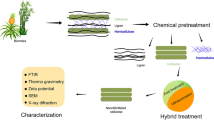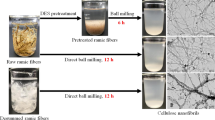Abstract
Partial enzymatic hydrolysis is a green alternative to chemical processes to facilitate the isolation of cellulose nanofibers (CNFs). In this work, we compared the production of CNFs from two sugarcane bagasse substrates (bleached and bleached-sulfonated) using partial enzymatic hydrolysis with the commercial cocktail Cellic CTec3®, followed by ultrasonication. The effect of pretreatments and enzyme dosage on CNF properties and yields were evaluated. Mild enzymatic hydrolysis applied to sulfonated samples using only 0.312 mg enzyme/g substrate for 6 h increased CNF yield up to 2.5-fold and resulted in micrometer length fibers with an average diameter between 5 and 6 nm, as demonstrated by detailed morphological characterization of the substrates. These results were achieved due to the combination of the delignification steps and sulfonation, which enhanced enzymatic hydrolysis and fibrillation efficiency. Furthermore, combining enzymatic hydrolysis and sulfonation increased the CNF thermal stability (56–111 °C for bleached and 87–97 °C for bleached and sulfonated samples). These results demonstrated a pivotal role of enzymes in green CNF production and revealed the optimized hydrolysis/pretreatment conditions for manufacturing CNFs with advanced properties using enzymatic mixtures.






Similar content being viewed by others
Data Availability
Not applicable.
References
Ämmälä A, Laitinen O, Sirviö JA, Liimatainen H (2019) Key role of mild sulfonation of pine sawdust in the production of lignin containing microfibrillated cellulose by ultrafine wet grinding. Ind Crop Prod 140:111664. https://doi.org/10.1016/j.indcrop.2019.111664
Arantes V, Dias IKR, Berto GL et al (2020) The current status of the enzyme-mediated isolation and functionalization of nanocelluloses: production, properties, techno-economics, and opportunities. Cellulose 27:10571–10630. https://doi.org/10.1007/s10570-020-03332-1
Banerjee G, Car S, Scott-Craig JS et al (2011) Alkaline peroxide pretreatment of corn stover: effects of biomass, peroxide, and enzyme loading and composition on yields of glucose and xylose. Biotechnol Biofuels 4:16. https://doi.org/10.1186/1754-6834-4-16
Bangar SP, Whiteside WS (2021) Nano-cellulose reinforced starch bio composite films—a review on green composites. Int J Biol Macromol 185:849–860. https://doi.org/10.1016/j.ijbiomac.2021.07.017
Bayer T, Cunning BV, Šmíd B et al (2021) Spray deposition of sulfonated cellulose nanofibers as electrolyte membranes in fuel cells. Cellulose 28:1355–1367. https://doi.org/10.1007/s10570-020-03593-w
Berto GL, Mattos BD, Rojas OJ, Arantes V (2021) Single-step fiber pretreatment with monocomponent endoglucanase: defibrillation energy and cellulose nanofibril quality. ACS Sustain Chem Eng. https://doi.org/10.1021/acssuschemeng.0c08162
Bhattacharjee S (2016) DLS and zeta potential—what they are and what they are not? J Control Release 235:337–351. https://doi.org/10.1016/j.jconrel.2016.06.017
Blanco A, Monte MC, Campano C et al (2018) Chapter 5: nanocellulose for industrial use: cellulose nanofibers (CNF), cellulose nanocrystals (CNC), and bacterial cellulose (BC). In: Mustansar Hussain C (ed) Handbook of nanomaterials for industrial applications. Elsevier, pp 74–126
Camargos CHM, Rezende CA (2021) Structure–property relationships of cellulose nanocrystals and nanofibrils: implications for the design and performance of nanocomposites and all-nanocellulose systems. ACS Appl Nano Mater 4:10505–10518. https://doi.org/10.1021/acsanm.1c02008
Chandra J, George N, Narayanankutty SK (2016) Isolation and characterization of cellulose nanofibrils from arecanut husk fibre. Carbohydr Polym 142:158–166. https://doi.org/10.1016/j.carbpol.2016.01.015
de Aguiar J, Bondancia TJ, Claro PIC et al (2020) Enzymatic deconstruction of sugarcane bagasse and straw to obtain cellulose nanomaterials. ACS Sustain Chem Eng 8:2287–2299. https://doi.org/10.1021/acssuschemeng.9b06806
de Campos A, Correa AC, Cannella D et al (2013) Obtaining nanofibers from curauá and sugarcane bagasse fibers using enzymatic hydrolysis followed by sonication. Cellulose 20:1491–1500. https://doi.org/10.1007/s10570-013-9909-3
De France KJ, Hoare T, Cranston ED (2017) Review of hydrogels and aerogels containing nanocellulose. Chem Mater 29:4609–4631. https://doi.org/10.1021/acs.chemmater.7b00531
Errokh A, Magnin A, Putaux J-L, Boufi S (2018) Morphology of the nanocellulose produced by periodate oxidation and reductive treatment of cellulose fibers. Cellulose 25:3899–3911. https://doi.org/10.1007/s10570-018-1871-7
Ferreira ES, Rezende CA, Cranston ED (2021) Fundamentals of cellulose lightweight materials: bio-based assemblies with tailored properties. Green Chem 23:3542–3568. https://doi.org/10.1039/D1GC00326G
Fukuzumi H, Saito T, Okita Y, Isogai A (2010) Thermal stabilization of TEMPO-oxidized cellulose. Polym Degrad Stabil 95:1502–1508. https://doi.org/10.1016/j.polymdegradstab.2010.06.015
Hafemann E, Battisti R, Bresolin D et al (2020) Enhancing chlorine-free purification routes of rice husk biomass waste to obtain cellulose nanocrystals. Waste Biomass Valor 11:6595–6611. https://doi.org/10.1007/s12649-020-00937-2
Han X, Bi R, Oguzlu H et al (2020) Potential to produce sugars and lignin-containing cellulose nanofibrils from enzymatically hydrolyzed chemi-thermomechanical pulps. ACS Sustain Chem Eng 8:14955–14963. https://doi.org/10.1021/acssuschemeng.0c05183
Hanhikoski S, Solala I, Lahtinen P et al (2020) Fibrillation and characterization of lignin-containing Neutral sulphite (NS) pulps rich in hemicelluloses and anionic charge. Cellulose 27:7203–7214. https://doi.org/10.1007/s10570-020-03237-z
Hideno A, Abe K, Yano H (2014) Preparation using pectinase and characterization of nanofibers from orange peel waste in juice factories. J Food Sci 79(6):N1218–N1224. https://doi.org/10.1111/1750-3841.12471
Isogai A, Zhou Y (2019) Diverse nanocelluloses prepared from TEMPO-oxidized wood cellulose fibers: nanonetworks, nanofibers, and nanocrystals. Curr Opin Solid State Mater Sci 23:101–106. https://doi.org/10.1016/j.cossms.2019.01.001
Kane AO, Pellergini VOA, Espirito Santo MC, Ngom BD, García JM, Acevedo A, Polikarpov I (2022) Evaluating the potential of culms from sugarcane and energy cane varieties grown in Argentina for second-generation ethanol production. Waste Biomass Valorization 1–15. https://doi.org/10.1007/s12649-021-01528-5
Katz S, Beatson R, Anthony M (1984) The determination of strong and weak acidic groups in sulfite pulps. Sven Papperstidn 87:48–53
Kedzior SA, Gabriel VA, Dubé MA, Cranston ED (2021) Nanocellulose in emulsions and heterogeneous water-based polymer systems: a review. Adv Mater 33:2002404. https://doi.org/10.1002/adma.202002404
Khadraoui M, Senthil A, Khiari R et al (2023) In situ sulfonation steam explosion: energy efficient for lignocellulosic micro/nanofibrils production. Ind Crop Prod 202:117067. https://doi.org/10.1016/j.indcrop.2023.117067
Klemm D, Cranston ED, Fischer D et al (2018) Nanocellulose as a natural source for groundbreaking applications in materials science: today’s state. Mater Today 21:720–748. https://doi.org/10.1016/j.mattod.2018.02.001
Lima MA, Gomez LD, Steele-King CG et al (2014) Evaluating the composition and processing potential of novel sources of Brazilian biomass for sustainable biorenewables production. Biotechnol Biofuels 7:10. https://doi.org/10.1186/1754-6834-7-10
Lin X, Wu Z, Zhang C et al (2018) Enzymatic pulping of lignocellulosic biomass. Ind Crop Prod 120:16–24. https://doi.org/10.1016/j.indcrop.2018.04.033
Liu X, Jiang Y, Wang L et al (2020) Tuning of size and properties of cellulose nanofibers isolated from sugarcane bagasse by endoglucanase-assisted mechanical grinding. Ind Crop Prod 146:112201. https://doi.org/10.1016/j.indcrop.2020.112201
Nascimento SA, Rezende CA (2018) Combined approaches to obtain cellulose nanocrystals, nanofibrils and fermentable sugars from elephant grass. Carbohyd Polym 180:38–45. https://doi.org/10.1016/j.carbpol.2017.09.099
Nechyporchuk O, Belgacem MN, Bras J (2016) Production of cellulose nanofibrils: a review of recent advances. Ind Crop Prod 93:2–25. https://doi.org/10.1016/j.indcrop.2016.02.016
Norrrahim MNF, Ariffin H, Yasim-Anuar TAT et al (2021) Performance evaluation of cellulose nanofiber with residual hemicellulose as a nanofiller in polypropylene-based nanocomposite. Polymers 13:1064. https://doi.org/10.3390/polym13071064
Pinto LO, Bernardes JS, Rezende CA (2019) Low-energy preparation of cellulose nanofibers from sugarcane bagasse by modulating the surface charge density. Carbohyd Polym 218:145–153. https://doi.org/10.1016/j.carbpol.2019.04.070
Rambabu N, Panthapulakkal S, Sain M, Dalai AK (2016) Production of nanocellulose fibers from pinecone biomass: Evaluation and optimization of chemical and mechanical treatment conditions on mechanical properties of nanocellulose films. Ind Crops Prod 83:746–754. https://doi.org/10.1016/j.indcrop.2015.11.083
Rezende CA, de Lima MA, Maziero P et al (2011) Chemical and morphological characterization of sugarcane bagasse submitted to a delignification process for enhanced enzymatic digestibility. Biotechnol Biofuels 4:54. https://doi.org/10.1186/1754-6834-4-54
Rol F, Saini S, Meyer V et al (2019) Production of cationic nanofibrils of cellulose by twin-screw extrusion. Ind Crop Prod 137:81–88. https://doi.org/10.1016/j.indcrop.2019.04.031
Rossi BR, Pellegrini VOA, Cortez AA et al (2021) Cellulose nanofibers production using a set of recombinant enzymes. Carbohyd Polym 256:117510. https://doi.org/10.1016/j.carbpol.2020.117510
Santo ME, Rezende CA, Bernardinelli OD, Pereira JN, Curvelo AA, Deazevedo ER, Polikarpov I (2018) Structural and compositional changes in sugarcane bagasse subjected to hydrothermal and organosolv pretreatments and their impacts on enzymatic hydrolysis. Ind Crops Prod 113:64–74. https://doi.org/10.1016/j.indcrop.2018.01.014
Silva CEP, Tam KC, Bernardes JS, Loh W (2020) Double stabilization mechanism of O/W Pickering emulsions using cationic nanofibrillated cellulose. J Colloid Interf Sci 574:207–216. https://doi.org/10.1016/j.jcis.2020.04.001
Siqueira G, Bras J, Dufresne A (2010) Luffa cylindrica as a lignocellulosic source of fiber, microfibrillated cellulose and cellulose nanocrystals. BioResources 5(2):727–740
Siqueira GA, Dias IKR, Arantes V (2019) Exploring the action of endoglucanases on bleached eucalyptus kraft pulp as potential catalyst for isolation of cellulose nanocrystals. Int J Biol Macromol 133:1249–1259. https://doi.org/10.1016/j.ijbiomac.2019.04.162
Sluiter A, Hames B, Ruiz R et al (2008) Determination of structural carbohydrates and lignin in biomass. NREL-Laboratory Analytical Procedure (LAP)
Valls C, Pastor FIJ, Roncero MB et al (2019) Assessing the enzymatic effects of cellulases and LPMO in improving mechanical fibrillation of cotton linters. Biotechnol Biofuels 12:161. https://doi.org/10.1186/s13068-019-1502-z
Wu G, Heitz M, Chornet E (1993) The depolymerization of Lignin via aqueous alkaline oxidation. In: Bridgwater AV (ed) Advances in thermochemical biomass conversion. Springer Netherlands, Dordrecht, pp 1558–1571
Zhang K, Zhang Y, Yan D et al (2018) Enzyme-assisted mechanical production of cellulose nanofibrils: thermal stability. Cellulose 25:5049–5061. https://doi.org/10.1007/s10570-018-1928-7
Zhou H, St. John F, Zhu JY (2019) Xylanase pretreatment of wood fibers for producing cellulose nanofibrils: a comparison of different enzyme preparations. Cellulose 26:543–555. https://doi.org/10.1007/s10570-019-02250-1
Acknowledgments
We thank Fundação de Amparo à Pesquisa do Estado de São Paulo (FAPESP), Conselho Nacional de Desenvolvimento Científico e Tecnológico (CNPq) and Coordenação de Aperfeiçoamento de Pessoal de Nível Superior—Brasil (CAPES) for project funding. The authors also thank INCT/INOMAT for TEM access, Prof. Fernando Galembeck for AFM access, and Dr. Douglas S. da Silva (in memoriam) for his technical support.
Funding
This work was supported by Fundação de Amparo à Pesquisa do Estado de São Paulo (FAPESP) (grants 2015/13684-0, 2018/23769-1, 2019/19360-3, 2021/12071-6 and 2021/08780-1) and by Conselho Nacional de Desenvolvimento Científico e Tecnológico (CNPq) (grants 306852/2021-7 and 420031/2018-9). This study was financed in part by the Coordenação de Aperfeiçoamento de Pessoal de Nível Superior—Brasil (CAPES)—Finance Code 001.
Author information
Authors and Affiliations
Contributions
All authors contributed to the study conception and design. Material preparation, data collection and analysis were performed by all the authors. The first draft of the manuscript was written by E.S. and all authors commented on previous versions of the manuscript. All authors read and approved the final manuscript.
Corresponding author
Ethics declarations
Conflict of interest
The authors declare no competing interests.
Ethical approval and consent to participate
Not applicable.
Consent for publication
Not applicable.
Additional information
Publisher’s Note
Springer Nature remains neutral with regard to jurisdictional claims in published maps and institutional affiliations.
Aissata Ousmane Kanea, Eupidio Scopeb have contributed equally to this work.
Electronic supplementary material
Below is the link to the electronic supplementary material.
Rights and permissions
Springer Nature or its licensor (e.g. a society or other partner) holds exclusive rights to this article under a publishing agreement with the author(s) or other rightsholder(s); author self-archiving of the accepted manuscript version of this article is solely governed by the terms of such publishing agreement and applicable law.
About this article
Cite this article
Kane, A.O., Scopel, E., Cortez, A.A. et al. Enzyme-assisted production of cellulose nanofibers from bleached and bleached/sulfonated sugarcane bagasse: impact of sulfonation on nanocellulose properties and yields. Cellulose 30, 11507–11520 (2023). https://doi.org/10.1007/s10570-023-05600-2
Received:
Accepted:
Published:
Issue Date:
DOI: https://doi.org/10.1007/s10570-023-05600-2




